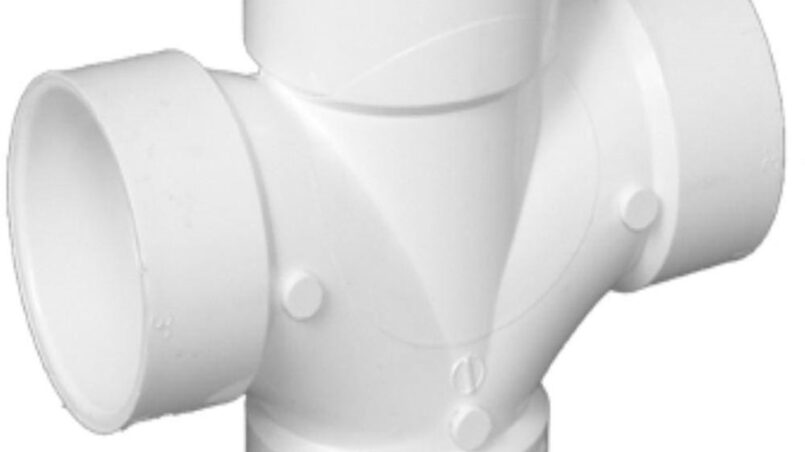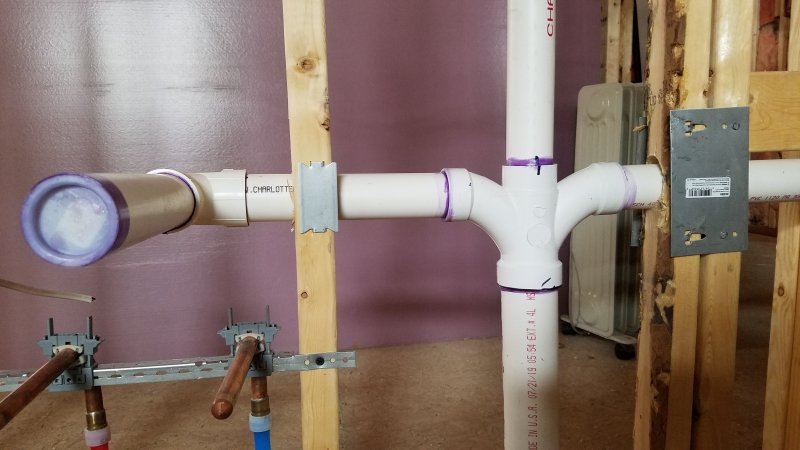A double sanitary tee type is used for changing the direction of drainage flows and connecting horizontal drains to vertical drains in plumbing systems. The difference between a wye and a double sanitary tee is that a double sanitary tee has less sweep to the side inlets.
It is not allowed to use a double sanitary tee horizontally unless it is a wet vent, as the fixture draining into the wet vent will prevent the accumulation of solids. In drainage systems, a double sanitary tee is primarily used to connect horizontal drains to vertical drains, with the center connection leading to a trap.
The barrel of the double sanitary tee must be two pipe sizes larger than the largest of the two inlet pipes to be used correctly.
Introduction To Double Sanitary Tee
A double sanitary tee is an essential component in plumbing systems that connects horizontal drains to vertical drains. It allows for a change in direction of drainage flows, ensuring smoother and more efficient liquid flow. This versatile fitting is commonly used in residential, commercial, and industrial plumbing installations. In this article, we will explore the different types and uses of double sanitary tees, as well as the key differences between a double sanitary tee and a wye fitting.
Definition Of A Double Sanitary Tee
A double sanitary tee, also known as a double fixture tee, is a plumbing fitting that features a curved center section and two side inlets. Its shape allows for the connection of two drain pipes at a 90-degree angle. The center connection is typically used to connect to the pipe leading to a trap, ensuring proper drainage and preventing blockages.
Why Is A Double Sanitary Tee Used?
A double sanitary tee is used in plumbing systems for several reasons:
- To connect horizontal drains to vertical drains: The primary purpose of a double sanitary tee is to connect horizontal drain pipes to vertical drain pipes, allowing for a change in direction of drainage flow.
- To accommodate fixture installations: In back-to-back fixture installations, where two fixtures are located in close proximity, a double sanitary tee is used to connect both fixtures to the main drain line.
- To improve drainage efficiency: The curved center section of a double sanitary tee promotes smoother and more efficient liquid flow, reducing the risk of blockages and ensuring proper drainage.
Difference Between Wye And Double Sanitary Tee
While a double sanitary tee and a wye fitting serve similar purposes, there are key differences between the two:
| Wye Fitting | Double Sanitary Tee |
|---|---|
| A wye fitting has a Y-shaped configuration with one inlet and two outlet connections. | A double sanitary tee has a curved center section with two side inlets and one center outlet connection. |
| A wye fitting is commonly used in drainage systems where the flow needs to be divided. | A double sanitary tee is primarily used to connect horizontal drains to vertical drains. |
| In a wye fitting, the two outlet connections are typically at a 45-degree angle. | In a double sanitary tee, the two side inlets are at a 90-degree angle. |
Overall, both fittings are essential in plumbing systems but serve different purposes. The choice between a wye fitting and a double sanitary tee depends on the specific requirements of the plumbing installation.
double sanitary tee types
A double sanitary tee is a crucial plumbing fitting used to connect horizontal drains to vertical drains in a drainage system. It has two horizontal inlets and one vertical inlet, allowing for efficient liquid flow and connection to a trap. There are several types of double sanitary tees available, each serving specific purposes and adhering to various plumbing codes.
Standard Sanitary Tee
A standard double sanitary tee is the most commonly used type of double sanitary tee. It features two horizontal inlets and one vertical inlet, all of which are at 90-degree angles to one another. This type of tee is suitable for most plumbing applications where a change in direction is required.
With Side Inlet
A double sanitary tee with a side inlet is designed to accommodate additional fixtures or drainage connections. It features two horizontal inlets, one vertical inlet, and a smaller side inlet. This side inlet allows for the connection of a separate drainage line or fixture, providing flexibility in plumbing installations.
With Side Inlet Against Code
While a double sanitary tee with a side inlet offers versatility in plumbing installations, it is important to note that using this type of tee may be against plumbing codes in some regions. Certain plumbing codes prohibit the use of a double sanitary tee with a side inlet for specific applications. It is essential to check local plumbing codes before using this type of tee to ensure compliance and prevent potential issues in the future.
Uses Of The Sanitary Tee In Plumbing
The double sanitary tee is commonly used in plumbing to connect horizontal and vertical pipes, allowing for a smoother flow of liquids. It is essential for efficient drainage systems and is preferred over other fittings like the Wye due to its superior performance.
Connecting Horizontal Drains To Vertical Drains
A double sanitary tee is an essential component in plumbing systems when it comes to connecting horizontal drains to vertical drains. Its curved center section allows for smoother and more efficient liquid flow. This type of tee is specifically designed to facilitate the connection between horizontal and vertical drains, making it a crucial element in any plumbing setup.
By using a double sanitary tee, plumbers can ensure a seamless flow of wastewater from the horizontal drain to the vertical drain. This helps prevent any blockages or backups that may occur when drains are not properly connected. The center connection of the tee is usually attached to the pipe leading to a trap, further improving the overall functionality and performance of the plumbing system.
Use In Back-to-back Installations
In addition to connecting horizontal and vertical drains, a double sanitary tee also finds great utility in back-to-back installations. When two plumbing fixtures, such as sinks or toilets, share a common wall, a double sanitary tee is often used to connect their waste pipes efficiently.
With a double sanitary tee, plumbers can seamlessly merge the waste pipes of the two fixtures, allowing for a proper discharge of wastewater into the drainage system. This ensures that both fixtures are effectively connected to the main plumbing line, preventing any potential clogs or backups.
Alternatives To Sanitary Tee
While a double sanitary tee is an excellent choice for many plumbing applications, there are alternatives available depending on the specific plumbing setup. One common alternative is the use of two individual sanitary tees with a short horizontal pipe connection.
Instead of using a single double sanitary tee, plumbers can install two separate sanitary tees and connect them with a horizontal pipe between the two inlets. This alternative method allows for the same functionality as a double sanitary tee, providing a connection between horizontal and vertical drains in a back-to-back installation.
It’s important to consult with a professional plumber to determine the most suitable option for your specific plumbing needs. Whether it’s a double sanitary tee or an alternative method, ensuring proper connections and efficient wastewater flow is crucial for the overall performance of your plumbing system.
Frequently Asked Questions For Double Sanitary Tee: Types And Uses
When Would You Use A Double Sanitary Tee?
A double sanitary tee can be used when the barrel of the tee is two pipe sizes larger than the largest inlet pipe.
What Is The Difference Between Wye And Double Sanitary Tee?
The main difference between a Wye and a double sanitary tee is the direction of drainage flows. A Wye fitting allows for a change in direction, while a double sanitary tee has less sweep to the side inlets. However, a double sanitary tee can be used if the barrel is two pipe sizes larger than the largest inlet pipe.
Can A Double Sanitary Tee Be Used Horizontally?
No, a double sanitary tee should not be used horizontally. It is only allowed for vertical drainage connections.
What Is A Pvc Sanitary Tee Used For?
A PVC sanitary tee is used to connect horizontal drains to vertical drains in plumbing systems. It allows for smoother, more efficient liquid flow and is typically connected to the pipe leading to a trap. It cannot be used horizontally unless the barrel of the tee is two pipe sizes larger than the inlet pipes.
Conclusion
To conclude, a double sanitary tee is a versatile plumbing fitting that is used to connect horizontal drains to vertical drains. It is especially useful when a change in direction of drainage flow is needed. However, it is important to ensure that the barrel of the tee is two pipe sizes larger than the largest of the two inlet pipes for proper functionality.
Understanding the types and uses of double sanitary tees can greatly benefit plumbing projects and ensure efficient liquid flow in drainage systems.
















